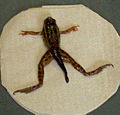User:LiquidGhoul/Frog
| Frogs | |
|---|---|

| |
| Pobblebonk, Australia | |
| Scientific classification | |
| Kingdom: | |
| Phylum: | |
| Class: | Amphibia |
| Order: | |
| Suborders | |
The term frog is the common name for
Characteristics
Frogs range in size from less than 50mm to 300mm (the
The skin unkeratinized and hangs loosely on the body because of the lack of loose connective tissue, and can be smooth or warty.
Generally, frogs have long legs with webbed toes, and
Croaking
Many species of frog have deep calls, or croaks. Frog noise tends to be spelt (for English speakers) as "crrrrk" in
Poison
Some species of frog secrete
Distribution and status
Frogs are found nearly worldwide, but they do not occur in Antarctica and are not present on many oceanic islands.
In many parts of the world, the
Life cycle
The life cycle of frogs contains many stages. Typically, the male frogs of a species will assemble at a still water source. They will then call, collectively becoming a chorus of frogs. The call is unique to the species, and will attract females of that species.
The male and female frog, will then undergo amplexus. This involves the male mounting the female. The female then releases her egss, which the male frog covers with a sperm solution before the eggs make contact with the water. Once the eggs come in contact with the water, they will swell, and form a protective coating. The eggs are typically brown or black, with a clear, gelatine like, covering.
The eggs will hatch after a short time, releasing
Most temperate species of frog reproduce in the period between late autumn to early spring. In the
-
Frogspawn
-
10 days: Tadpoles
-
8–12 weeks: Froglet
-
12–16 weeks: Adult frog
Diet and Predators
Most frogs eat
Many animals eat frogs. These include
Frogs in popular culture
Frogs feature prominently in
- In the 1992 animated movie Freddie as FRO7, Frederick, an enchanted frog prince with magical powers, becomes a modern-day secret agent.
- The .
- Probably the most famous frog in the entertainment world is the Muppet character Kermit the Frog.
- Until recently, the American TV network The WB (Warner Brothers) used Michigan J. Frog, a frog in a tuxedo as their logo. Michigan J. Frog was the singing, dancing star of the 1955 Warner cartoon, "One Froggy Evening".
- Frogger is an early electronic arcade game which features a frog that must cross a busy road and river.
- Frogs fall from the sky in various urban myths and notably in the movie Magnolia. This may derive from incidents when frogs are picked up by a tornado, or when a sudden migration of frogs happens overnight.
- The behavior of frogs illustrating nonaction is a myth. ("Take a pot of hot water and a frog. Throw the frog into the pot. What do you think will happen? The obvious, of course: the frog will jump out. Who likes hanging around in a pot of hot water? Now ... [t]ake a pot of cold water, put the frog in it, and place the pot on the stove. Turn on the heat. This time something different will occur. The frog, because of the incremental change in temperature, will not notice that it is slowly being boiled." from "Life and Death in the Executive Fast Lane" by Manfred Kets de Vries) Professor Doug Melton, Harvard University Biology Department, says, "If you put a frog in boiling water, it won't jump out. It will die. If you put it in cold water, it will jump before it gets hot -- they don't sit still for you." [1] A frog put anywhere that doesn't kill it will jump, "they don't sit still for you."
- Paul McCartney's " Rupert and the Frog Song" was released in 1984 and reached no.3 in the British Charts.
External links
- The Whole Frog Project - Virtual frog dissection and anatomy
- Disappearance of toads, frogs has some scientists worried - San Francisco Chronicle, April 20, 1992
- The Lily Pad - Frog information, care, and culture
- Racing Frogs Game - Create, Train, Motivate and Feed your own little froggy friend
- The Froggy Page - Frog fun
- Dart Den - Dart frog resource and forums
- Xenbase - A Xenopus laevis and tropicalis Web Resource
- Time-lapse video showing the egg's development until hatching
- Frogs (1977) - when frogs go bad



